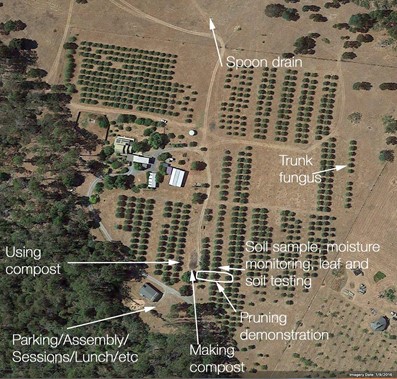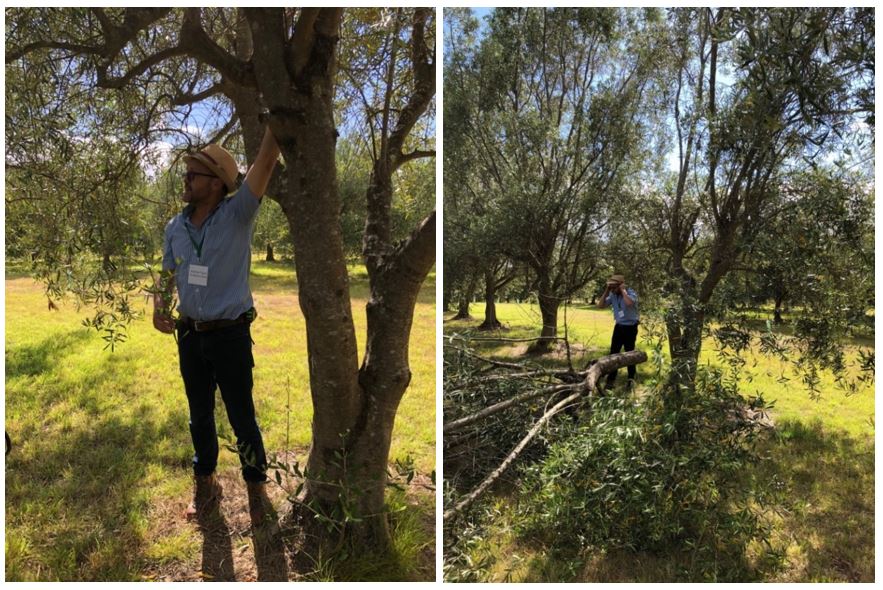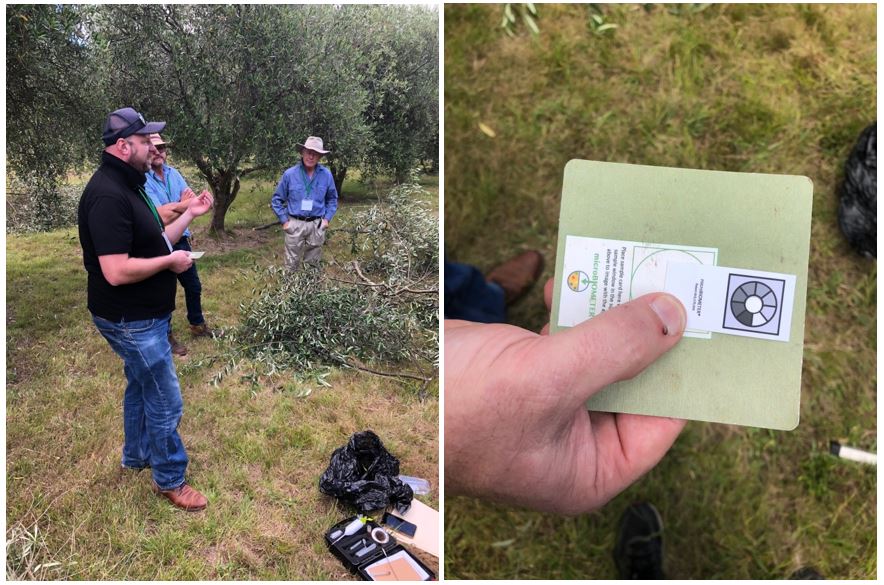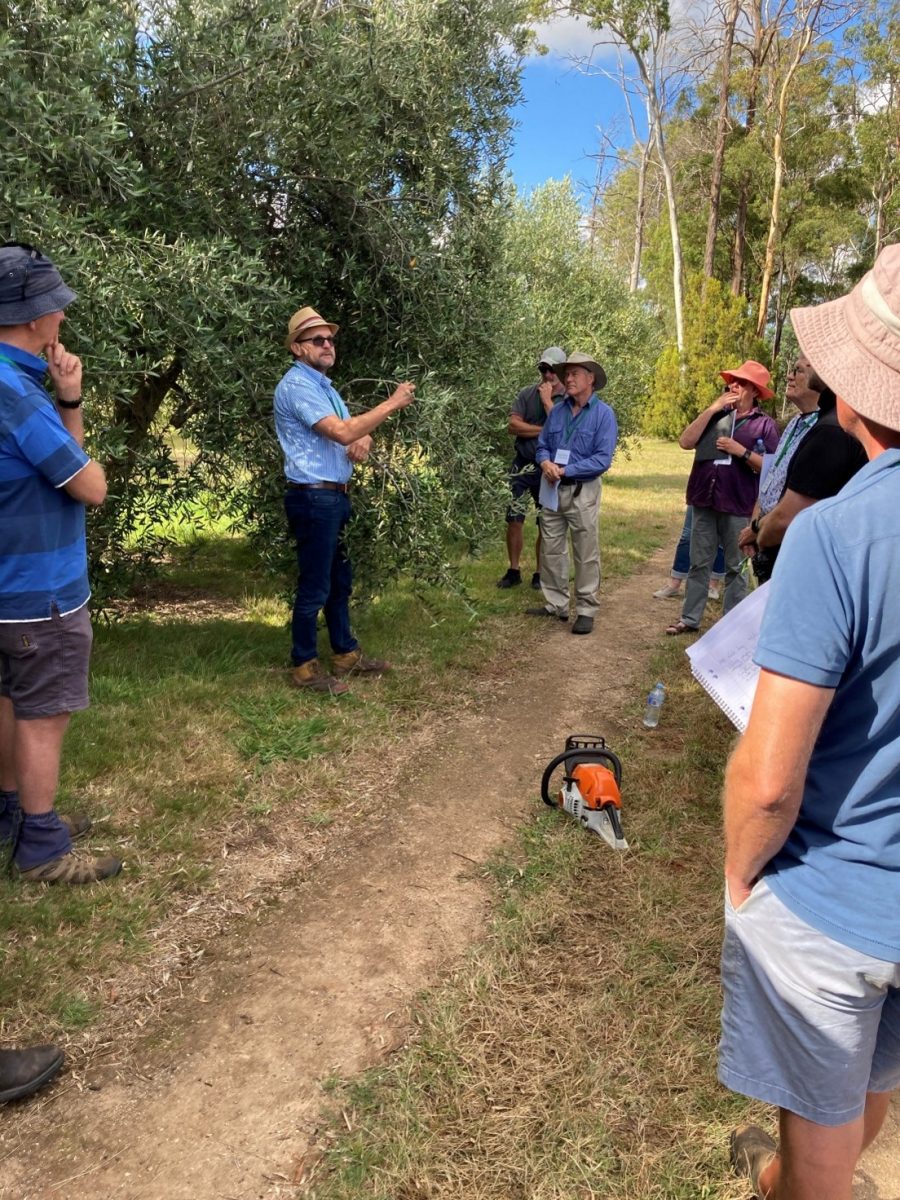02 Mar TAS Healthy Soils Field Day Report
February 2021

Lentara Grove is one of Tasmania’s oldest olive groves, located in Tasmania’s beautiful Tamar Valley, near Exeter, 30 minutes north of Launceston. In 2015 Lentara Grove came up for sale, offering over 700 mature olive trees on 20 hectares and with established processing facilities onsite. Martin and Sophie Grace seized the opportunity. Despite both having desk jobs, the couple learnt the ropes of olive growing and pressing, and quickly turned their new hobby into a thriving business. Their small grove of 24 year old trees is located on a north-facing slope on a ridge above the Tamar River – this site provides generous amounts of sunlight to ripen the olives to perfection as well as the perfect soil conditions to keep the trees happy.
Martin and Sophie are all about sustainable farming – treating their trees and farm respectfully so their environment remains as pristine as possible, their trees are as happy as possible and Lentara Grove produce a diverse range of products all grown, picked, processed, packed and labelled on site.

Lentara Grove hosted the recent AOA Healthy Soils Field Day
AOA ‘healthy soils’ field day at Lentara Grove well received.
A small but enthusiastic group of 12 olive producers representing 9 Tasmanian olive groves attended a very successful field day hosted by EVOO and table olive producers Martin & Sophie Grace of Lentara Grove situated in the Tamar Valley at Exeter.
Participants travelled from across Tasmania including Flinders Island and the Tamar Valley in the north to the Huon Valley and Bruny Island in the south of the state.
The Australian Olive Association (AOA) is convening this series of ground-breaking field days to be held across Australia with a refreshing ‘in the field’ demonstration approach – definitely no PowerPoint!
The field day series emphasises the important role of healthy soils in producing healthy trees and lifting grove productivity.
Noting a 2019 AOA grower survey that revealed that Australian grove productivity ranges from zero to 15 tonne / ha, with median production <1.0 tonne / ha, and average production of 3.3 tonne / ha, clearly demonstrating the low productivity of many groves in Australia, reflecting the need to address critical grove management issues.
AOA is also emphasising the value of benchmarking grove performance – setting Key Performance Indicators (KPIs) for improved grove productivity and profitability, including:
- Grove productivity KPIs: kg / tree, tonnes / ha ;
- Cost of production – cost $/tonne;
- Gross margin – $/ha
The value of participating in AOA’s OliveCare® Best Practice Program was also covered, including the use of best practice management checklists, and having access to technical time critical management information.
Download AOA’s talking points on the OliveCare® best practice program here.
OliveCare® members are able to log in to access additional best practice checklists here.
TAS field day participants were treated to a grove walk that covered important grove productivity topics including practical demonstrations covering a range of grove management issues, including:
Canopy Management with olive grove specialist Andrew Taylor (SA)

Andrew Taylor pointing out 25 year old wood that needs to be rejuvenated over a 6- 8 year cycle.
Andrew Taylor is a horticulturalist previously based in Hawkes Bay, New Zealand, on a 53 ha property just outside Napier with his wife Delyth and two children growing olives, apples and grazing stock; as well as providing harvest contractor and grove advisory services to the NZ olive industry. Andrew also held the position of President of Olives New Zealand for a period of 9 years retiring from this role in 2018. Being a grower himself Andrew is familiar with the risks and rewards of horticulture and the need for groves to be well managed for positive financial outcomes. In 2018 Andrew and his family moved to South Australia, where Andrew now provides grove management services to SA largest olive producer Pendleton Estate situated in the Limestone Coast region. Andrew explained and demonstrated:
- Pruning for sunlight/shade pattern
- Pruning for tree row volume
- Pruning for harvest method
- Pruning for leaf/wood ratio
- Pruning as cultural practise for disease control
- Pruning for renewal
- Pruning for frost reduction
- Pruning for consistent production
- Use of temperature data loggers
View Andrew Taylor in action Video (7.5 mins):
Download AOA’s technical notes on significant pests and diseases of the olive tree here.
Access Professor Robert Spooner-Hart’s IPDM project resources here.
Soil health and leaf and soil nutrition monitoring with Peter Briscoe from Bioptiv (VIC)

Peter Briscoe demonstrating a MicroBIOMETER® that measures the ratio of soil bacteria to fungi
Peter Briscoe is head of global sales of Bioptiv. (Bioactive Soil Solutions was sold to Bioptiv (AUS) in April 2020). Bioptiv (AUS) has the IP, licenses, permits, product range and customer base of Bioactive Soil Solutions and we are continuing the 10+ years of great work Bioactive Soil Solutions began in the agricultural biological industry. We have a range of exciting new initiatives to ensure that we can provide a more holistic approach to biological farming methods and soil improvement amendments including an expanded range of biological offerings and plant based carbon products.
A major point made is that it is essential for growers to undertake both soil and leaf analysis, and pH to enable a more accurate diagnosis of actual nutrient deficiency, and in designing a grove nutrition program. Sample the same soil sites and trees at least annually to enable comparable data and to read trends.
Peter explained and demonstrated:
- How do you maintain productive groves while streamlining nutrient requirements?
- How do you manage applications of fertilisers to optimise plant uptake and minimise losses to run-off, leaching or gas emissions?
- When should I take soil and leaf tests?
- Why is soil pH important?
- What fertiliser methods should I use?
- How do I improve soil biology and carbon in my soils?
- Building soil nitrogen and nitrogen fixation
- The use of soil amendments to correct sodic and acidic soils
Download Peter’s talking points on soil health and grove nutrition here.
The MicroBIOMETER®

Research shows that microbial biomass (fungi and bacteria) is the leading indicator of soil health. Living soil fixes nutrients, improves plant immunity, stores water more efficiently and builds soil structure, therefore, a healthy level of microbes increases productivity while reducing inputs.
The microBIOMETER® measures the microbial biomass of soil, compost, and compost teas and extracts. It also calculates the fungal to bacterial ratio for soil and compost. This data allows you to track the health of your soil over time. Microbial biomass is calculated and displayed in micrograms of microbial-carbon per gram of soil (μg/g) and fungal to bacterial ratio is calculated and displayed as F:B, F% and B%.
Note: Iron rich soil can have iron nanoparticles. These are red particles in the same size range as microbes, which have buoyant densities that prevent their being precipitated during settling time, and which may affect the test readings. Work is being undertaken to include a magnetic settling step in the instructions for use. Further details and instructions for use of the microBIOMETER® is available at: https://microbiometer.com/
Also available from The Meter Man (David von Pein) in Toowoomba, QLD (cost approx. $300 including 20 tests): https://www.themeterman.com.au/microbial-biomass-tester-kit.php
Making and using compost with John Barton from Charton & Bang, Research & Development (NSW)

John Barton grew up on a rice farm near Griffith, NSW and worked in agriculture across a range of crop types. After sustaining a back injury John retrained in horticultural science, specialising in soil function and farm ecosystems. He has worked for 10 years in commercial composting at every level from machinery operator to business owner. He has been involved in the production of 1 million cubic metres of compost and has been involved in the commissioning and staff training of 5 new composting sites around Australia. John is passionate about creating sustainable farms and soils that can produce food forever with degrading. John explained and demonstrated:
- Composting
- Compost recipe
- Compost application rates
- Soil water
- Collecting more water
- Holding more water
- Giving back more water
- Soil carbon
- Living carbon
- Simple carbon
- Complex carbon
- How we lose soil carbon
- How we can build soil carbon
- How to keep soil carbon
- Measuring soil carbon
Download John’s talking points on composting and soil carbon here.
Download Compost for Soils trial at Regans Ford olive grove WA here, and Guide your Compost Application here.
Click here for more on compost and composting including useful resources links.
Click here for more on compost and composting including useful resource links.

TAS field day participants described their field day experience as ‘awesome’ and ‘best field day ever’.
Healthy soils field day inspiration:
Martin & Sophie Grace have now decided to commence a comprehensive tree skirting program at Lentara Grove to improve airflow through the grove, which will assist with frost management as well as pest and disease management. In addition they have decided to commence major regeneration pruning on one of their blocks, to bring down the height of the trees and regenerate more young fruiting wood. These prunings will be chipped and used together with olive processing waste (together with some high nitrogen local animal manure) to commence a composting program at Lentara Grove.
Lentara Grove is also an AOA Conference field day site for October 2021; it will be interesting to see how these grove initiatives have progressed by that time.
It will also be interesting to hear what other field day participants have been inspired to do with their field day learnings.
